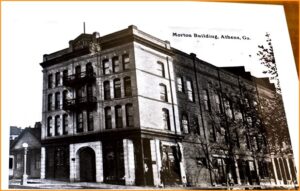 The Morton Building, Home of the Historic Morton Theatre
The Morton Building, Home of the Historic Morton Theatre
Built in 1910 by Monroe Bowers (“Pink”) Morton, the Morton Theatre is one of the first, and the oldest surviving, vaudeville theatres in the United States, uniquely built, owned, and operated by an African American. In its heyday, the Morton Theatre hosted early acts such Butterbeans and Susie, Blind Willie McTell, Curley Weaver, Cab Calloway, and Bessie Smith. The theatre also experienced the dawn of the silver screen as a movie house. The Morton Building housed not only the theatre, but also many of Athens’ black doctors, dentists, pharmacists, and other professionals. The fully restored Morton Theatre is listed in the National Register of Historic Places and was adapted as a performing arts space through the 1987 citizen-approved SPLOST (Special Projects Local Option Sales Tax) funding in 1993. Learn more about the Morton Theatre’s History.
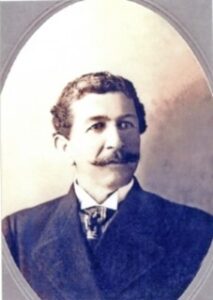 Monroe “Pink” Morton
Monroe “Pink” Morton
The original builder, owner, and operator of the Morton Building, and founder of the Morton Theatre, Monroe Bowers Morton, was born in May 1853 in Athens. Morton was the son of a white father and an African American mother. (Morton’s mother was a former slave of mixed descent.) He acquired the nickname “Pink” among family and friends, which was originally a reference to his complexion. Morton attended a secret school led by Reverend James Sims in Savannah before the American Civil War brought emancipation to Georgia. He later attended the Knox Institute in Athens and then became a messenger for Major John J. Knox of the Freedmen’s Bureau.
Although he had very little education, Pink Morton was an ambitious man. He tried his hand at several occupations before establishing himself as a building contractor. His reputation as a contractor and his active role in the construction industry allowed him to be the contractor for the Wilkes County Courthouse in Washington, Georgia, and he participated in the construction of a government building in Anniston, Alabama. Morton was chosen as a delegate to the Republican National Convention in 1896. He was appointed to the committee that officially informed William McKinley of his nomination as the party’s candidate for President.

Pink Morton’s Change of Base, The Atlanta Constitution, 15 Aug 1884, Page 10
The following year, 1897, Morton was appointed as the U.S. Postmaster of Athens, Georgia. He remained in this post for the next five years, garnering high praise from local citizens for his performance.
Another well-known fact is that Pink Morton owned between twenty-five to thirty buildings in the Athens area, including a $10,000 marble-stone building on Clayton Street. The building continues to stand and houses one of the many retail establishments in downtown Athens.
Morton Building Origin
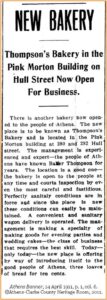
Many businesses owned by African Americans operated out of the Morton Building, including Thompson’s bakery which opened in 1911.
In 1909, Morton purchased the land for the Morton Building for $2,175 in cash. The first floor would be for offices and retail, and the rest would be for the theater. It has been alleged that the design specifications for the Morton Theatre were adapted from an architectural design for a renovation to the nearby New Opera House, drawn up by Chicago architect Frank Cox.
The Morton Building was completed on May 18, 1910. The Morton Theatre was opened that same evening with a classical piano concert by Alice Carter Simmons. The Morton Theatre was the first African American built, owned, and operated vaudeville theatre in the state. Pink Morton acted as the Morton Theatre’s lighting and/or stage director for many of the performances.
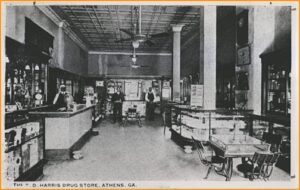
The J.D. Harris Drug Store, inside the Morton Building
The Morton Building was home to various business occupants, including the Ellington D. Harris Drug Company, the first African American owned drugstore in Athens. The practice of Dr. Blanche Thompson, the first black surgeon in Athens, was part of the Drug Company. The dental practice of the first licensed Georgia’s African American female dentist, Dr. Ida Mae Hiram, was next door in the Samaritan Building, which has since been torn down.
As owner and operator of the building, Morton used the rent collected from the various businesses housed in the Morton Building to subsidize the operation of the theatre.
A bustling center of economic activity, the Morton Building was an inspiration to anyone who walked past. Even in the harshest of the Jim Crow South, African American Athenians found a way to prosper here.
Monroe Bowers “Pink” Morton’s Final Years
By 1914 Morton was the owner, publisher, and editor of the Progressive Era, a local black newspaper. Unfortunately, few copies of the newspaper are known to have survived from the period of his ownership. Five years after establishing this newspaper Monroe Bowers “Pink” Morton died at the age of 66. Morton is buried in the Morton family lot at Gospel Pilgrim Cemetery in Athens.
More about Dr. Blanche Thompson.
Dr. Thompson attended Atlanta University and following a short first marriage to Robert Saunders which left her a widow, she continued her education at Walden University in Nashville. Bishop Henry McNeal Turner of the A.M.E. church was so thoroughly impressed with her diligence and scholarship that he financed her medical education at Meharry Medical College.
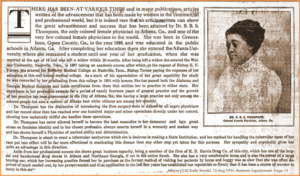
Dr. Thompson graduated with honors in 1901 and became the first African American female to practice medicine in Athens, Georgia. She cared for both African American and white patients, and she performed the first surgery by an African American physician in Athens. Dr. Thompson was part owner of the E. D. Harris Drugstore, the first African American owned drugstore in Athens.
More about Dr. Ida Mae Hiram
Early Years
Ida Mae Johnson was born to Fayette and Short Johnson in Athens, Georgia. Her father was a former slave, who ran away from his bondage at a young age and established himself in Athens. At the age of six, Ida lost her mother, leading to her father raising her by himself. Her relatives would tell her stories of her grandfather and her great great grandmother. Her grandfather was brought from Africa as part of the slave trade and was described as “a tall, broad-shouldered man” who frequently ran away from the plantation. Her great great grandmother was Native American, but much about her Native American ancestry is unknown.
Her father put a large emphasis on education during Ida’s childhood, having her attend the Knox Institute, which was a segregated Black school in downtown Athens. Upon graduating from the Knox Institute, Ida looked to become a teacher. However, she ended up falling in love and marrying Lam Hiram, a dentist who worked in Athens. The couple had a child Alice, but Ida never forgot her dream of secondary education and wanted to pursue dentistry “to help [her husband] in his profession.” After her two-year hiatus from education, Ida decided to attend Meharry College in Nashville, Tennessee.
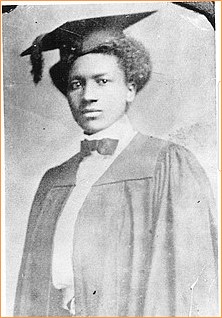
The birth of Dr. Ida Mae Hiram is celebrated on October 15, 1896. She was a Black dentist, activist, and administrator who lived most of her life in Athens, GA.
Breaking through Barriers
Ida spent four years acquiring first her bachelor’s and then her dentistry degree, visiting her family during the holidays. During her time at the university Ida met many other Black female doctors, but no dentists. When she graduated from dental school in 1910, she was one of two women who passed the State Board Dental Examination. After receiving her dental license, she returned home to Athens and joined her husband’s practice, located on the second floor of an office building. Known for her gentleness and care with patients, she was often called “the painless dentist.” According to the 1930 US census, there were 10,110 Black professionals in Georgia, the majority being clergymen and teachers, accounting for just under one percent of the population.
This led to the Great Migration in which a large portion of the black population in the south moved north to try to get jobs in factories. During the economic decline, her husband decided to open a second practice up north. This led to Ida running the practice in Athens with the help of her daughter Alice, who had taken dentistry classes and was an assistant. Alice married Z. T. Hubert, Jr. in 1935 and formed her own insurance business. Ida and Lam were able to buy a house in a suburb just north of the University of Georgia. For the vast majority of Ida’s life in Athens, there was no racial justice progress. The commercial-civic elite in Athens and other southern cities had long abided Jim Crow segregation.
Black businesses and individuals had struggles getting loans and struggled to compete with white-owned businesses. The first large step towards the 20th century American Civil Rights Movement came after the return of black troops from World War II. The dissatisfaction with racial injustice led to many landmark movements and decisions, but the one that affected Athens the most was Brown v. Board which made segregation of educational institutions illegal. Then governor Talmadge made a public statement after the release of the decision that “as long as [he was] Governor, Negros will not be admitted to white schools.” After a long legal battle, the University of Georgia desegregated in 1961. As such she was able to live through the period relatively unscathed, eventually buying a house. She maintained a dental practice in Athens for 55 years, finally closing her office in the Morton Building at the age of 80. Ida Mae Hiram resided at 635 W. Hancock Street until her death in 1979 at the age of 83.
More about Dr. Ilda Mae Hiram from the African American Registry and from the Hargrett Collection.
